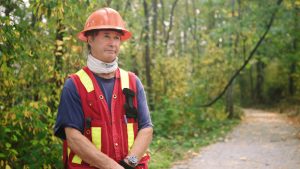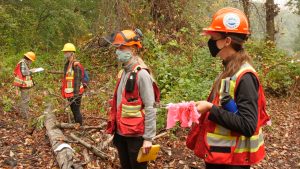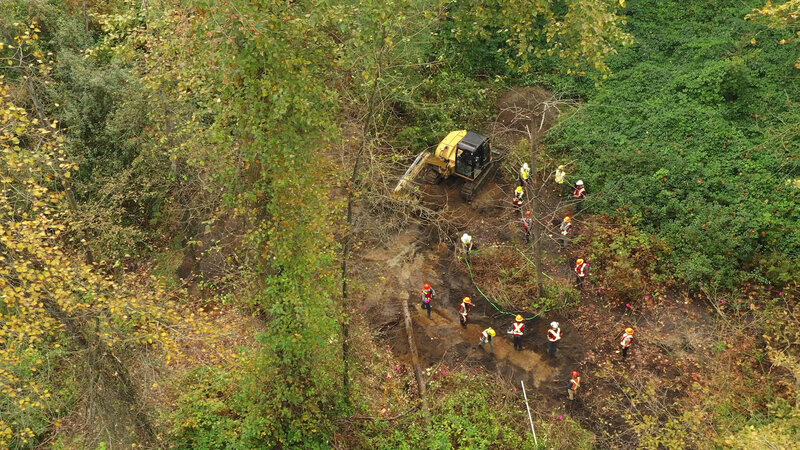
Frogs, birds, critters, and the community now have a newly-built wetland to enjoy on the south end of the BCIT Burnaby Campus, near Guichon Creek.
The biodiversity hotspot — constructed by students as part of a three-day field course — isn’t just good for the environment, it’s also a living example of how programs at BCIT have been able to pivot during the pandemic.
“BCIT worked extremely hard over the summer with the faculty to figure out how we were going to deliver a traditionally very hands-on program — like ecological restoration — to the students, and do it in a COVID-19 compliant way,” says Ken Ashley, Director of the BCIT Rivers Institute, standing at the site of the school’s first ever wetland, located near Lot L and surrounded by trees.
The hands-on experience of building and restoring a real-life wetland is an important part of the Ecological Restoration Degree Program at BCIT, including the undergraduate class, Wetland and Estuary Restoration.
Usually students in this class go on a field trip to Logan Lake for their hands-on experience in wetland building, restoration or maintenance. But due to the COVID-19 pandemic, the weeklong trip to BC’s interior was canceled. As BCIT is committed to delivering applied education for our students, it was important to find another way to deliver the same type of learning experience.
Creating a living lab of sustainability
Ken had an idea.
He dug up a plan he’d proposed to BCIT to build a small wetland right on the Burnaby campus, involving staff and students from the School of Construction and the Environment — including Ecological Restoration (ER), Forest and Natural Areas Management (FNAM), and Fish, Wildlife and Recreation (FWR) programs — all working together in collaboration.
With support from the BCIT SOCE’s Dean’s Collaborative Student Project Initiative, Ken’s idea came to life.
Students wouldn’t have to travel and the school would get a new “living lab” for the whole community to enjoy.
Plans took shape over the summer.
Facilities even volunteered to build the proposed wooden walkway, says Ken, likely constructed next summer.
There will also be educational signage put up, and this will let people enjoy the space even more.
“It will highlight the value of having this unique ‘living lab’— with the forest and Guichon Creek at the South end of campus — and it will allow students to go out and use it,” says Ken.
It’s inspired by Camosun Bog in Vancouver, a self-guided nature walkway where people learn about things like sphagnum moss and vascular plants. Ken spent a lot of time there exploring the terrain as a child and even played hockey on the frozen bog during winter months — well before he became an expert on such habitats.
Transforming an empty space into a vibrant and ecologically key wetland

They rolled up their sleeves for three full days in September, in what Ken coined, “RENR 8106/ECOR 9301: Wetland Field course – 2020 COVID-19 version 2.0,” — a nod to the changing landscape of 2020. They combined two wetland classes, including 24 undergraduates, and six graduate-level participants.
“We wanted to make it very much what would have been there 100 years ago,” says Ken. “There was a remnant wetland there, so we kind of stayed within that area.”
Students broke into three teams of about 10 students, tasked with things like moving rocks, monitoring ground water levels, salvaging native plants and pulling out invasive ones, planting seedlings and mapping out the best plan.
And they did it all with COVID-19 safety protocols in place, sanitizing tools like shovels, wearing masks, social distancing, and so on.
Because the wetland is on campus, the students who built it can easily watch it develop and thrive in the years to come.
“That wetland is going to be there a hundred years from now so it’s pretty satisfying when you make a permanent improvement to the landscape,” says Ken, adding it’s already filling in nicely and will only improve with time. “It’s a phenomenal feeling.”
A wetland is a boost of biodiversity

Wetlands are loosely defined as areas partially submerged by water for at least part of the year. Canada has a quarter of the planet’s wetlands, including bogs, fens, peatlands, swamps, and shallow waters.
Reclaiming wetlands — and creating new ones — is important work, Ken explains, since so many wetlands have been lost through things like agriculture, forestry, and development.
“When you put a wetland in, you really get a boost of biodiversity,” says Ken. “And from a climate point of view, they store a huge amount of carbon which is really important.”
That’s not all.
“They’re called the kidneys of the landscape,” he adds, since they help remediate environmental problems by filtering pollutants or sediment.
And from a social perspective, interactive outdoor spaces are more important than ever.
“It’s also going to be a place where people in the community can go and immerse themselves in nature,” reflects Ken. “Everybody needs a little peace of mind these days and that’s partly what this will allow.”
Learn more about applied learning at BCIT, including how the Institute continues to deliver the applied instruction, collaborative experience, and industry connections that students can expect from a BCIT credential.
Ken Ashley is the Director of the Rivers Institute at BCIT, an Instructor in the BCIT Ecological Restoration program, and is an Adjunct Professor in Civil Engineering at UBC. His 2019 documentary film, Heart of the Fraser, focuses on the impacts humans are having on this sensitive area.
(Story written by Chantal Eustace)

This is a brilliant initiative! Kudos to all involved.